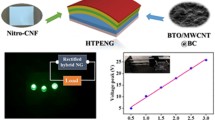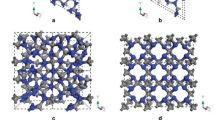Abstract
Developing high value-added utilization of abundant waste peels could alleviate increasingly environmental concerns and promote economic returns to the industry. In this report, a common waste tomato peel was selected and developed as the bio-piezoelectric membrane for nanogenerator derived self-powered sensor in multifunctional applications. The membrane with a thickness of about 40 μm is composed of nano-layers stacked together, resulting in a laminated structure. The nano-layer is assembled by the interstitial parallel combination of the nanocrystalline microfibrils of cellulsoe Iβ embedded in the amorphous matrix containing hemicellulose and lignin. The ordered cellulose Iβ chain network linked by hydrogen bond in the nanocrystalline microfibrils with a crystal grain size of 1.093 nm is responsible for the piezoelectric effect of the membrane. As a result, a favorable linear relation with an R2 of 0.984 between voltage and force and a sensitivity of 16.17 mV N−1 are given for the membrane based device. Owing to the multiple characteristics of the device, such as nontoxicity, self-powered capability, flexibility and multifunctionality, its potential is exhibited in three types of application scenarios, including human–computer interaction, harvesting wind and mechanical energy, and responding dangerous signal in alarming system.






Similar content being viewed by others
Data availability
Data will be available from the authors upon reasonable request.
References
M.K. Awasthi, S. Sarsaiya, A. Patel, A. Juneja, R.P. Singh, B. Yan, S..K.. Awasthi, A. Jain, T. Liu, Y. Duan, A. Pandey, Z. Zhang, M.J. Taherzadeh, Refining biomass residues for sustainable energy and bio-products: an assessment of technology, its importance, and strategic applications in circular bio-economy. Renew. Sustain. Energy Rev. 127, 109876 (2020)
X. Cao, Y. Xiong, J. Sun, X. Zhu, Q. Sun, Z.L. Wang, Piezoelectric nanogenerators derived self-powered sensors for multifunctional applications and artificial Intelligence. Adv. Funct. Mater. 31(33), 2102983 (2021)
Z. Han, P. Jiao, Z. Zhu, Combination of piezoelectric and triboelectric devices for robotic self-powered sensors. Micromachines 12(7), 813 (2021)
J.L. Birman, Theory of the piezoelectric effect in the zincblende structure. Phys. Rev. 111(6), 1510 (1958)
S.K. Ghosh, D. Mandal, Effificient natural piezoelectric nanogenerator: Electricity generation from fish swim bladder. Nano Energy 28, 356–365 (2016)
J. Sun, H. Guo, J. Ribera, W. Changsheng, T. Kunkun, M. Binelli, G. Panzarasa, F.W.M.R. Schwarze, Z.L. Wang, Ingo Burgert, Sustainable and biodegradable wood sponge piezoelectric nanogenerator for sensing and energy harvesting applications. ACS Nano 14(11), 14665–14674 (2020)
S. Maiti, S.K. Karan, J. Lee, A.K. Mishra, B.B. Khatua, J.K. Kim, Bio-waste onion skin as an innovative nature-driven piezoelectric material with high energy conversion efficiency. Nano Energy 42, 282–293 (2017)
S.K. Karan, S. Maiti, S. Paria, A. Maitra, S.K. Si, J.K. Kim, B.B. Khatua, A new insight towards eggshell membrane as high energy conversion effificient bio-piezoelectric energy harvester. Mater. Today Energy 9, 114–125 (2018)
S.K. Ghosh, D. Mandal, Bio-assembled, piezoelectric prawn shell made self-powered wearable sensor for non-invasive physiological signal monitoring. Appl. Phys. Lett. 110, 123701 (2017)
S.K. Ghosh, D. Mandal, High-performance bio-piezoelectric nanogenerator made with fish scale. Appl. Phys. Lett. 109, 103701 (2016)
J. Kim, N. Wang, Yi. Chen, S.-K. Lee, G.-Y. Yun, Electroactive-paper actuator made with cellulose/NaOH/urea and sodium alginate. Cellulose 14, 217–223 (2017)
J. Kim, S. Yun, Discovery of cellulose as a smart material. Macromolecules 39, 4202–4206 (2006)
D. Sarkar, M. Namrata Das, Md. Saikh, P. Biswas, S. Das, S. Das, N.A. Hoque, R. Basu, Development of a sustainable and biodegradable Sonchus asper cotton Pappus based piezoelectric nanogenerator for instrument vibration and human body motion sensing with mechanical energy harvesting applications. ACS Omega 6(43), 28710–28717 (2021)
C. Fritsch, A.S.A. Happel, M.A.C. Márquez, I. Aguiló-Aguayo, M. Abadias, M. Gallur, I.M. Cigognini, D. Angela Montanari, M.J. López, F. Suárez-Estrella, N. Brunton, E. Luengo, L. Sisti, M. Ferri, G. Belotti, Processing, valorization and application of bio-waste derived compounds from potato, tomato, olive and cereals: A review. Sustainability 9, 1492 (2017)
F. Jiang, Y.-L. Hsieh, Cellulose nanocrystal isolation from tomato peels and assembled nanofifibers. Carbohyd. Polym. 122, 60–68 (2015)
A.R. Celma, F. Cuadros, F. Lopez-Rodriguez, Characterization of pellets from industrial tomato residues. Food Bioprod. Process. 90(C4), 700–706 (2012)
P.G. Herrera, M.C. Sanchez-Mata, M. Camara, Nutritional characterization of tomato fiber as a useful ingredient for food industry. Innov. Food Sci. Emerg. Technol. 11(4), 707–711 (2010)
M. Del Valle, M. Camara, M.E. Torija, Chemical characterization of tomato pomace. J. Sci. Food Agric. 86(8), 1232–1236 (2006)
V.A. Bazhenov, Piezoelectric properties of woods (Consultants Bureau, New York, 1961)
S.H. Kim, C.M. Lee, K. Kafle, Characterization of crystalline cellulose in biomass: basic principles, applications, and limitations of XRD, NMR, IR, Raman, and SFG. Korean J. Chem. Eng. 30(12), 2127–2141 (2013)
Y. Song, Z. Shi, G.H. Hu et al., Recent advances in cellulose-based piezoelectric and triboelectric nanogenerators for energy harvesting: a review. J. Mater. Chem. A 9(4), 1910–1937 (2021)
M. Zhang, H. Du, K. Liu et al., Fabrication and applications of cellulose-based nanogenerators. Adv. Compos. Hybrid Mater. 4(4), 865–884 (2021)
E. Espinosa, J. Domínguez-Robles, R. Sánchez, Q. Tarrés, A. Rodríguez, The effect of pre-treatment on the production of lignocellulosic nanofifibers and their application as a reinforcing agent in paper. Cellulose 24, 2605–2618 (2017)
P. Adapa, C. Karunakaran, L. Tabil, G. Schoenau, Potential applications of infrared and Raman spectromicroscopy for agricultural biomass. Agric. Eng. Int.: CIGR J. 8, 1081 (2009)
D.S. Himmelsbach, D.E. Akin, Near-Infrared–Fourier-Transform–Raman spectroscopy of flax (Linum usitatissimum L.) stems. J. Agric. Food Chem. 46, 991–998 (1998)
Y. Xue, X. Qiu, Wu. Ying, Y. Qian, M. Zhou, Y. Deng, Y. Li, Aggregation-induced emission: the origin of lignin fluorescence. Polym. Chem. 7(21), 3502–3508 (2016)
A.L. Barnette, L.C. Bradley, B.D. Veres, E.P. Schreiner, Y.B. Park, J. Park, S. Park, S.H. Kim, Selective detection of crystalline cellulose in plant cell walls with sum-frequency-generation (SFG) vibration spectroscopy. Biomacromol 12(7), 2434–2439 (2011)
J. Sugiyama, J. Persson, H. Chanzy, Combined infrared and electron diffraction study of the polymorphism of native celluloses. Macromolecules 24(9), 2461–2466 (1991)
D. Montesano, F. Fallarino, L. Cossignani, A. Bosi, M.S. Simonetti, P. Puccetti, P. Damiani, Innovative extraction procedure for obtaining high pure lycopene from tomato. Euro. Food Res. Technol. 226(3), 327–335 (2008)
F. Bettaieb, R. Khiari, A. Dufresne, M.F. Mhenni, M.N. Belgacem, Mechanical and thermal properties of Posidonia ocenica cellulose nanocrystal reinforced polymer. Carbohyd. Polym. 123, 99–104 (2015)
J. Sugiyama, R. Vuong, H. Chanzy, Electron diffraction study on the two crystalline phases occurring in native cellulose from an algal cell wall. Macromolecules 24, 4168–4175 (1991)
L. Segal, J.J. Creely, A.E. Martin, C.M. Conrad, An empirical method for estimating the degree of crystallinity of native cellulose using X-ray diffractometer. Text. Res. J. 29(10), 786–794 (1959)
Md. MehebubAlam, D. Mandal, Native cellulose microfifiber-based hybrid piezoelectric generator for mechanical energy harvesting utility. ACS Appl. Mater. Interfaces 8(3), 1555–1558 (2016)
Acknowledgements
This work was financially supported by Educational Commission of Jiangxi (KJLD13100; GJJ212301; GJJ212309), Natural Science Foundation of Jiangxi Province (20224BAB214023) and Research Project of Huzhou college (RK65007).
Funding
Foundation of Jiangxi Educational Commission, KJLD13100, Shunjian Xu, GJJ212301, Zonghu Xiao, GJJ212309, Ping Huang, Natural Science Foundation of Jiangxi Province, 20224BAB214023, Ping Huang, Research Project of Huzhou college, RK65007, Shunjian Xu
Author information
Authors and Affiliations
Contributions
SX: Methodology, Formal analysis, Writing—original draft. PH: Conceptualization, Writing—review & editing. YL: Supervision. YZ: Formal analysis. YW: Investigation. XL: Investigation. ZX: Resources. JF: Validation. ML: Validation.
Corresponding author
Ethics declarations
Competing interest
The authors declare no competing interest.
Additional information
Publisher's Note
Springer Nature remains neutral with regard to jurisdictional claims in published maps and institutional affiliations.
Supplementary Information
Below is the link to the electronic supplementary material.
Rights and permissions
Springer Nature or its licensor (e.g. a society or other partner) holds exclusive rights to this article under a publishing agreement with the author(s) or other rightsholder(s); author self-archiving of the accepted manuscript version of this article is solely governed by the terms of such publishing agreement and applicable law.
About this article
Cite this article
Xu, S., Huang, P., Luo, Y. et al. High value-added development of waste cellulose peels for bio-piezoelectric membrane in nanogenerator-derived self-powered sensor. J Mater Sci: Mater Electron 34, 1414 (2023). https://doi.org/10.1007/s10854-023-10844-6
Received:
Accepted:
Published:
DOI: https://doi.org/10.1007/s10854-023-10844-6




